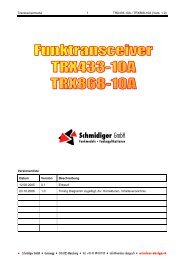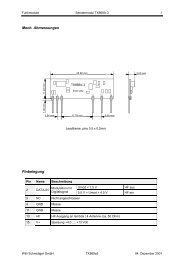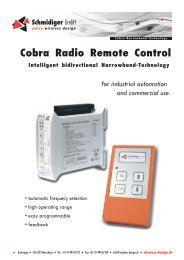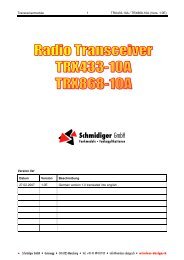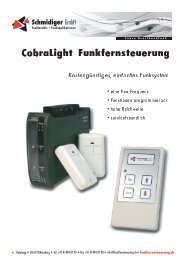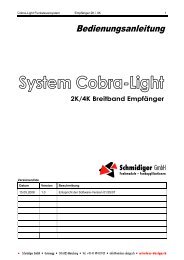Version List
Version List
Version List
You also want an ePaper? Increase the reach of your titles
YUMPU automatically turns print PDFs into web optimized ePapers that Google loves.
Transceiver module TRX433-10C2 / TRX868-10C2 (Vers. 1.0E) 4<br />
Family overview radio transceiver<br />
The radio transceivers of the family TRX433 and TRX868 are offered in several designs. Their difference is<br />
in the software and / or in hardware.<br />
At the moment, there are three versions A, B and C, which have the following differences:<br />
<strong>Version</strong> A <strong>Version</strong> B <strong>Version</strong> C<br />
Data interface RS232 any, transparent RS232<br />
Configuration over<br />
RS232<br />
Sleep, Wake up<br />
tasks<br />
Only the most important<br />
parameter, only possible<br />
by power up<br />
delay TX-RX 1 t DATA + tRADIO ,<br />
see timing diagram<br />
Comprehensive command<br />
set, configurable during<br />
operation at any time<br />
No Yes Yes<br />
6 t BIT-RADIO<br />
Jitter +- 1/8 t BIT-RADIO<br />
Comprehensive command<br />
set, configurable during<br />
operation at any time<br />
t DATA + tRADIO<br />
see timing diagram<br />
Error checking CRC16 None With / without CRC16<br />
Retransmit after<br />
failure<br />
Until the data are<br />
acknowledged correctly<br />
by the receiver<br />
No No<br />
Buffer size TX 2 x 31 bytes Ring buffer, 61 bytes 2<br />
Buffer size RX 1 x 31 bytes, ring buffer Ring buffer, 61 bytes 2<br />
Data handshake RTS-CTS, XON-XOFF RTS-CTS<br />
The three versions cover the demands of different usage as follows:<br />
<strong>Version</strong> A is for simple usage instead of cable e.g. between computer and peripheral device where the dead<br />
time through the transmission path does not matter. Data are checked by the transceiver with regard to<br />
faults. If faults are detected, data are repeated until correct reception. This version only sends the data when<br />
the buffer is full or when no further data is on hold during the time of 3ms. <strong>Version</strong> A and Evalkit3 are ideal<br />
for testing the radio range.<br />
<strong>Version</strong> B is used when the maximal control over the radio channel is necessary or desired. There is<br />
absolutely no coding or error checking done. The signal which is placed on the transmittion side is released<br />
transparently with a minimal delay 1:1 by the receiver. The signal has therefore an optimal compatibility to<br />
any way of coding and radio modules of other producers.<br />
<strong>Version</strong> C with a transparent byte mode is used when a short reaction time and at the same time the<br />
simplest activation is desired. The byte-by-byte incoming data are sent over radio with a short delay so that<br />
the receiver can start with the serial data output just a few milliseconds after the transmission of the 1 st data<br />
byte.<br />
When the error checking is active, the receiver outputs only correctly transmitted data. Without the error<br />
checking there, the higher-rated application has to take care of that.<br />
1 tBIT_RADIO : time period for 1 bit with the chosen RF data rate<br />
2 When the RF data rate is adjusted high enough in proportion to the RS232 baud rate then there occurs a<br />
continued data flow without a break through the handshake



